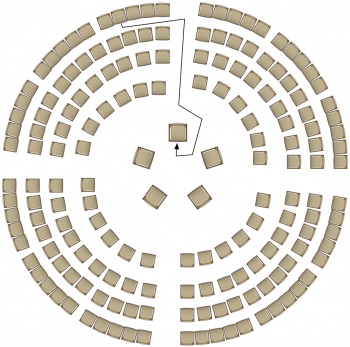Fishbowl Discussion
| Type | Team Size | ||||||
|---|---|---|---|---|---|---|---|
| Collaborative Tools | Software | Personal Skills | Productivity Tools | 1 | 2-10 | 11-30 | 30+ |
What, Why & When
A Fishbowl is a medium-length dialogue format for large groups, lead by a moderator. Four to five people discuss a question or topic while being surrounded by a typically much bigger audience, which is enabled to participate in the discussion by taking one of the chairs in the discussion group. The Fish Bowl format can be used for teaching (e.g. group discussions in seminars), for workshops (e.g. in work environments, events, organisational activities), or for stage discussions (e.g. on conferences). Depending on the context, the lenght of a fishbowl discussion can range from 15-20 minute sessions to more than an hour, with 30-45 minutes being rather typical.
Goal
- Engage the whole audience in a discussion in an active and structured manner, which makes the discussion more interesting, lively and and richer in perspectives.
Getting started

- In a typical Fishbowl, four to five chairs are arranged in a circle, with a larger number of chairs forming another circle around them. In a variation, only two chairs may be placed for a face-to-face conversation. Participants for the discussions, including one moderator, occupy the chairs, with the audience filling the surrounding chairs. This arrangement (see visualisation) gives the Fishbowl its name. The discussants should be rather heterogenous to allow for an interesting and potentially controversial discussion.
-
There are two different forms of the Fishbowl:
- The open Fishbowl, where one chair is left empty and any audience member may, at any time of the discussion, enter the discussion circle, take the chair and thus force one of the discussants to leave his/her own chair and go back into the audience. Instead of leaving one chair unoccupied, the audience members may also tap one participant on the shoulder to indicate them to leave.
- The closed fishbowl, where an audience member may only enter the stage when one of the discussants leaves after a pre-determined amount of time.
- The audience member that takes the free chair immediately receives the right to speak. In general, only one person is allowed to speak at a time, with the moderator ensuring a respectful discussion. The amount of audience members that participate in the discussion depends on the size of the audience, the purpose of the discussion and the time budget. (commonly 30-45 minutes).
- The discussion should be led by the moderator in a way that makes everybody feel like they can contribute. Questions should not be too specific or complex for the general audience to understand and the moderator (as well as the other discussants) should provide a feeling of welcoming all opinions and levels of expertise.
- A challenge with the Fishbowl format is that shy people are often not joining the discussion as much as people who feel like they have a lot to say. In a classroom setting, this may be solved both by splitting the students into groups and thus limiting the size of the audience, as well as through time limits for each discussant so that all students have to participate at some point.
Links & Further reading
Sources
- INES STADE: Was ist Fishbowl? - Next Time Teaching: Everything that could go wrong with your fishbowl discussions
The author of this entry is Christopher Franz.